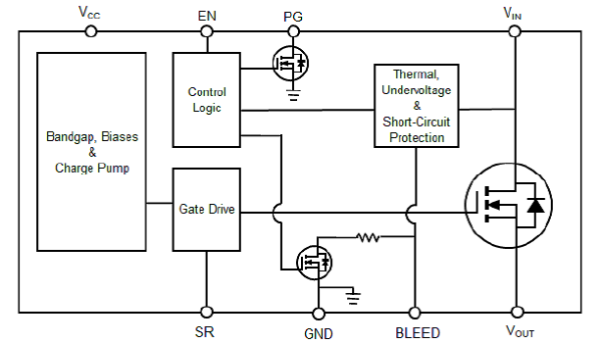The Latest Load Switches Leave Few Reasons to Design Your Own
By Muhammad Zafar Kausar, Junior Applications Engineer
Why Use a Load Switch?
Load switches are commonly used to turn system power rails on and off to maximize energy efficiency and ensure safe operation. Systems ranging from simple portable devices (like notebooks and tablets) to more complex equipment (such as set-top boxes, servers, gateways, industrial controllers, and network switches) may contain multiple power domains that are individually controlled and sequenced using load switches to ensure certain sections are started and allowed to stabilize before others. The load switch control logic can provide a power-good indicator that allows guaranteed-by-design power sequencing. A power-good indicator also permits general status monitoring and can be used to control other parts of the system.
Turning off idle circuitry using a load switch can significantly reduce overall power consumption. In a battery-powered application, designers can reduce demand on the battery this way to extend runtime, or to allow a smaller and more lightweight unit. Turning off unused circuitry can also lower the peak system power, which could permit lower-rated power circuitry to save on weight and bill of materials costs.
Load switches are also essential in controlling hot swapping. Allowing individual parts of a system, such as linecards in a telecom switch, to be replaced while others continue operating normally permits faster repairs with minimal disruption to services.
More Than Simply a Switch
At face value, the function of a load switch is straightforward; essentially, inserting a MOSFET in series between the power rail and the subsection of circuitry to be controlled, and applying a suitable signal to the gate, provides the desired control.
A basic load switch should be easy to build using only a few discrete components. Under the skin, however, it is more than simply a switch. Several additional functions are needed, which are essential to ensure system safety and reliability. Implementing these independently, using discrete components, takes time and adds to the complexity, cost, and PCB area.
Load-switch ICs, in contrast, have these features built-in, delivering a solution that is ready to use immediately, more compact, and more cost-effective. In addition, extra protection and quick-discharge circuitry come built into load switches, such as Diodes’ latest DML3006LFDS and DML3009LDC.
If a simple load switch is implemented using, say, a pMOS transistor, with no other precautions taken, a large inrush current can flow when the device is turned on, particularly if the load is highly capacitive. Excessive inrush current can be damaging to system components and can cause fluctuations in the main power-supply voltage, which could disrupt other parts of the system. Additional components are needed to limit the inrush current.
The DML3006LFDS (for load current up to 10.5A) and the 20A DML3009LDC contain a soft-start controller and charge pump that ensure constant slew rate, resulting in superior control of the inrush current. The DML3009LDC features an SR pin that allows the slew rate to be adjusted by connecting an external capacitor (figure 1).

Figure 1. Internal features and SR pin of Diodes’ DML3009LDC
Value-Added Features
As seen in figure 1, these load switches contain several other features that boost safety and reliability. These include internal bleed circuitry to discharge the load to ground after the MOSFET has been turned off, as well as thermal-shutdown protection that turns off the MOSFET to stop the flow of current if the junction temperature becomes excessive. Discrete MOSFETs typically have no such protection and can fail, leading to system malfunctions or damage to other components. Also included is short-circuit protection, which monitors the voltage across the MOSFET to protect the device and the system against high-current events, such as the output being shorted to ground; and undervoltage lockout protection, which turns the MOSFET off and activates the load bleed if the input voltage is dangerously low.
Implementing all these features with discrete components would result in a complex circuit that is time-consuming to design and occupies a large PCB area. In contrast, the DML3006LFDS and DML3009LDC require minimal external components and allow the solution to be implemented in a smaller PCB area than a basic discrete solution that provides only basic switching and inrush-current control. In addition, the switches contain MOSFETs of ultra-low on-resistance (typically from 10.8mΩ to less than 5mΩ depending on model), input voltage, and supply voltage. The standby current is extremely low (typically 0.1µA) when the MOSFET is turned off.
Conclusion
To sum-up, integrated load switches allow for a solution that is faster, easier, and more space-efficient to design than bringing up a circuit using individual components. By providing linear control over inrush current, additional built-in safety and protections, and features to minimize power dissipation, these devices leave few reasons – if any – to design your own load switches.
